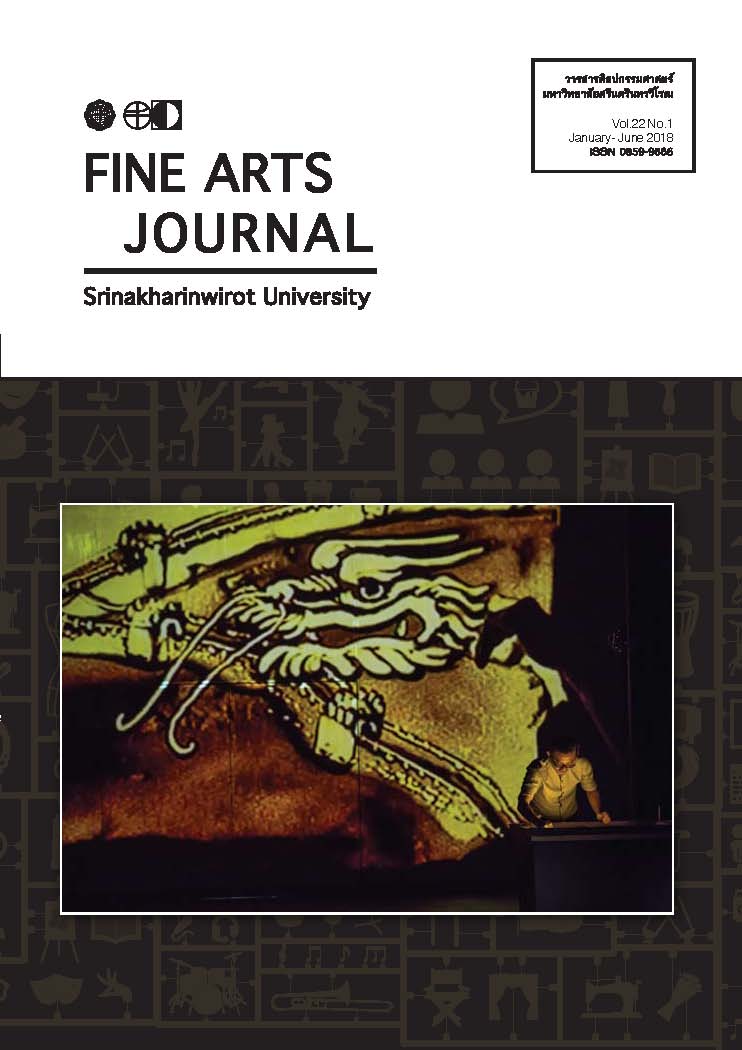การสร้างแบบจำลองมาริมบาเพื่อการเรียนการสอน วิชาทักษะดนตรีของนักเรียนระดับ ชั้นมัธยมศึกษาโดยใช้แนวคิดสัมพันธ์เชื่อมโยงของธอร์นไดค์
Keywords:
Marimba models, model, marimbal, Thorndike’s connectionism, teaching and learning, Music skills subjectAbstract
Though the number of Marimba enthusiast had overtaken the amount of available instruments in school, the selection of school was limited understandably due to the high price of it. With this reason, the researcher had assembled a faux marimba to study the efficiency of the teaching and learning music skills by using marimba with the support of Thorndike’s connectionism. The experiment results in:
1. The model is efficient with maintained according to standard.
2. The efficiency of the teaching and learning music skills by using marimba with the support of Thorndike’s connectionism was 80.55/80.88, exceeded the expected criterion.
According to the result, marimba model could be used in actual education with the support of the instructional design based on Thorndike’s connectionism, improving students’ musical performance. During the experiment, instructor deployed constant communication with a balanced rewarding system and careful suggestion which follows a strategy of Thorndike’s law of effect which determines that learner will continue to perform rewarding tasks while gradually leave out unsatisfactory habits.
Downloads
References
กำธร สนิทวงศ์. (2547). ดนตรีวิจักขณ์. กรุงเทพมหานคร: สำนักพิมพ์มหาวิทยาลัยรามคำแหง
คมสันต์ วงค์วรรณ์. (2551). ดนตรีตะวันตก. กรุงเทพมหานคร: สำนักพิมพ์แห่งจุฬาลงกรณ์ มหาวิทยาลัย
ณรุทธ์ สุทธจิตต์. (2540). สังคีตนิยม : ความซาบซึ้งในดนตรีตะวันตก. (พิมพ์ครั้งที่ 5). กรุงเทพมหานคร: สำนักพิมพ์แห่งจุฬาลงกรณ์มหาวิทยาลัย
ณรุทธ์ สุทธจิตต์. (2548). ดนตรีในปฐมวัยศึกษา. วารสารครุศาสตร์. 34(1), 3
ดนัย ลิมปดนัย. (2522). ดนตรีแห่งชีวิต. กรุงเทพมหานคร: สำนักพิมพ์ กราฟิคอาร์ต.
ดินป่า จีวัน. (2551). ดนตรีกับการพัฒนาคุณธรรม. วารสารการศึกษาปฐมวัย, 12(1), 41-44.
ทฤษฎีสัมพันธ์เชื่อมโยงของธอร์นไดค์ (Thorndike) (Connectionism Theory หรือ Bond Theory หรือ S - R Theory). (2553). สืบค้นเมื่อ ตุลาคม 10, 2557, จาก http://kasama26.blogspot.com/2010/11/thorndike-connectionism-theory- bond.html
ธีรโชติ เกิดแก้ว, อรรถสิทธิ์ สุนาโท, สมนึก ใจกล้า, วุฒิพงศ์ ทองก้อน, พรรณศิริ แจ่มอรุณ, ปราโมทย์ ชูเดช. (2550). สุนทรียภาพแห่งชีวิต. กรุงเทพมหานคร: มหาวิทยาลัยหัวเฉียวเฉลิมพระเกียรติ
นวัตกรรมและเทคโนโลยีทางการศึกษา. (2553). ทฤษฎีแนวคิดของธอร์นไดค์. สืบค้นเมื่อ กันยายน 20, 2557, จาก http://issary-orn.blogspot.com/2010/11/blog-post.html
นัฏฐิกา สุนทรธนผล. (2551). ชุดการสอนเทคนิคการออกเสียงของการบรรเลงเปียโน ARTICULATION : LEGATO, STACCATO, AND LEGATO – STACCATO สำหรับนักเรียนอายุระหว่าง 7-11 ปี. วิทยานิพนธ์ปริญญาศิลปศาสตร์มหาบัณฑิต บัณฑิตวิทยาลัย, มหาวิทยาลัยมหิดล.
นิโลบล หิรัญบุตร. (ม.ป.ป.). ดนตรีสากล. สืบค้นเมื่อ มกราคม 17, 2560, จาก https://sites.
google.com/site/agriculturebooksitem2/home.
ภูษิต แสนสุภา. (2552). ทฤษฎีการเรียนรู้. สืบค้นเมื่อ กันยายน 20, 2557, จาก https://www.gotoknow.org/posts/300302
Andre Previn's. (1984). Percussion. London: Warner Bros. Publication Inc.
Carl Fisher. (1981). RotoTom Technique ; 21 Progressive Etudes. New York: Carl Fishes, Inc.
Carl Fisher. (n.d.). The Solo Timpani ; 26 Etudes. New York: Carl Fishes, Inc.
James Blades. (1975). percussion instrument & their history. London: Robert Maclahose And Co. Ltd.
James Blades and Michael Skinner. (1981). Play Tuned Percussion ; First Solo And Duet. London: Caligraving Ltd.
James Holland. (1997). Percussion. Bucks, PA: Halstan & Co Ltd.
William F.Ludwig. (1979). The Ludwig Timpani Instructor. Chicago: Ludwig Industries.






